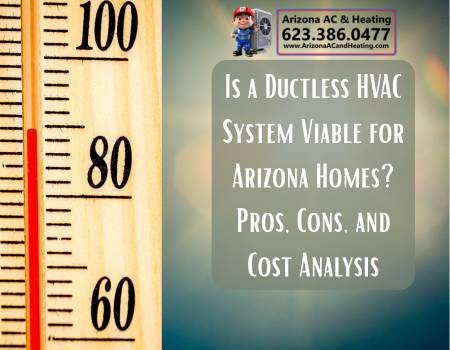 When you think of air conditioning in Arizona, central air systems are usually the first to come to mind. But as energy efficiency and zoning technology improve, more homeowners are asking a new question: Is a ductless HVAC system practical for Arizona’s hot climate? The short answer is yes, but it depends on your home’s layout, insulation, and cooling needs. Understanding how these systems perform in desert conditions helps you make an informed decision.
When you think of air conditioning in Arizona, central air systems are usually the first to come to mind. But as energy efficiency and zoning technology improve, more homeowners are asking a new question: Is a ductless HVAC system practical for Arizona’s hot climate? The short answer is yes, but it depends on your home’s layout, insulation, and cooling needs. Understanding how these systems perform in desert conditions helps you make an informed decision.
What Is a Ductless HVAC System?
Also known as a mini-split, a ductless HVAC system provides heating and cooling without the network of ducts used in traditional forced-air systems. Instead, it uses a small outdoor compressor connected to one or more indoor air handlers mounted on walls or ceilings. Each air handler cools a specific zone or room, offering personalized comfort and control.
In hot, dry climates like Arizona’s, ductless systems can be especially appealing because they eliminate the energy loss that occurs in ductwork, often up to 30% in older homes. This makes them an efficient alternative for spaces where installing ducts would be expensive or impractical, such as garages, additions, or older houses with limited attic space.
The Pros of Going Ductless in Arizona
1. Superior Energy Efficiency
Because ductless systems deliver air directly into each room, they avoid the losses that happen in traditional ductwork exposed to attic heat. This direct delivery is particularly beneficial in Arizona, where attic temperatures can exceed 140°F. Lower energy waste means reduced cooling costs, making ductless systems an eco-friendly and wallet-friendly option.
2. Zoned Cooling Comfort
One of the biggest perks of a ductless HVAC system is zone control. You can cool only the rooms you’re using, which is ideal for Arizona homes where some areas, like upstairs bedrooms or home offices, get much hotter than others. This flexibility helps you manage comfort without overworking your system.
3. Easier Installation
Installing ducts in an existing home can be costly and disruptive. Ductless systems require only small holes in the wall for refrigerant lines, making installation faster and less invasive.
4. Improved Indoor Air Quality
Since there are no ducts to collect dust, pollen, and debris, ductless systems can improve indoor air quality. Many models include multi-stage filtration, which helps reduce allergens and contaminants, a welcome benefit during Arizona’s dusty, windy seasons.
5. Year-Round Performance
Modern ductless mini-splits can both cool and heat your home. In Arizona’s mild winters, a ductless heat pump can efficiently maintain indoor comfort without relying on gas furnaces.
The Cons to Consider
1. Upfront Cost
While energy savings are attractive, ductless systems have higher upfront costs than some central air units. A single-zone mini split cost in the AZ climate typically ranges from $3,000 to $6,000 installed, while multi-zone systems for larger homes can exceed $10,000. However, the long-term energy savings and possible utility rebates can offset this over time.
2. Aesthetic Impact
Indoor air handlers are visible on your walls or ceilings. While newer models are sleek, some homeowners prefer the hidden vents of a central system.
3. Limited Air Distribution for Large Homes
For larger Arizona homes, central AC systems may still be more practical. A single mini-split can’t efficiently cool multiple large rooms, so you may need several units, which increases installation cost and maintenance complexity.
4. Maintenance Requirements
Ductless systems require regular cleaning of filters and coils to maintain performance. Neglecting maintenance can reduce efficiency and shorten lifespan, especially in Arizona’s dusty environment.
Ductless vs Central AC in a Hot Climate
When comparing ductless HVAC vs central AC in a hot climate, the biggest difference lies in efficiency and zoning. Central air systems cool the entire home uniformly, which can lead to wasted energy in unused spaces. Ductless systems, on the other hand, allow for customized cooling and use inverter-driven compressors that adjust speed to maintain consistent temperatures.
However, central AC systems generally handle larger cooling loads better and can integrate with whole-house ventilation and filtration systems. If your Arizona home already has well-insulated ducts, upgrading your existing central unit might make more sense financially.
Cost Analysis and Long-Term Value
A ductless HVAC system’s initial cost is higher, but it can pay off over time. Because it eliminates duct losses and allows for precise temperature control, many homeowners see a 20% to 40% reduction in their energy bills. Additionally, Arizona utilities sometimes offer rebates for energy-efficient mini-splits, making the investment more affordable.
When factoring in long-term costs, also consider the system’s lifespan. With proper care, a ductless mini-split can last 15 to 20 years, comparable to or even longer than many central AC systems.
The Bottom Line
So, is a ductless HVAC system in Arizona a good idea? For smaller homes, additions, or rooms with uneven cooling, absolutely. The ability to control temperatures room by room makes ductless systems efficient and convenient. For larger homes with existing ducts, upgrading your central AC might be the more cost-effective option.
In the end, the best choice depends on your home’s layout, insulation, and budget. Consulting a qualified HVAC professional ensures your system is sized and installed correctly for Arizona’s demanding heat. Whether you choose ductless or central air, optimizing energy efficiency will keep your home cool and comfortable through every scorching summer.
